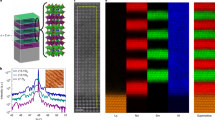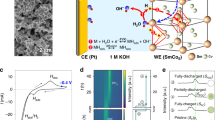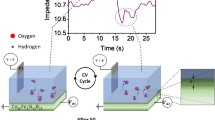Abstract
In metal/oxide heterostructures, rich chemical1,2, electronic3,4,5, magnetic6,7,8,9 and mechanical10,11 properties can emerge from interfacial chemistry and structure. The possibility to dynamically control interface characteristics with an electric field paves the way towards voltage control of these properties in solid-state devices. Here, we show that electrical switching of the interfacial oxidation state allows for voltage control of magnetic properties to an extent never before achieved through conventional magneto-electric coupling mechanisms. We directly observe in situ voltage-driven O2− migration in a Co/metal-oxide bilayer, which we use to toggle the interfacial magnetic anisotropy energy by >0.75 erg cm−2 at just 2 V. We exploit the thermally activated nature of ion migration to markedly increase the switching efficiency and to demonstrate reversible patterning of magnetic properties through local activation of ionic migration. These results suggest a path towards voltage-programmable materials based on solid-state switching of interface oxygen chemistry.
This is a preview of subscription content, access via your institution
Access options
Subscribe to this journal
Receive 12 print issues and online access
$259.00 per year
only $21.58 per issue
Buy this article
- Purchase on Springer Link
- Instant access to full article PDF
Prices may be subject to local taxes which are calculated during checkout






Similar content being viewed by others
References
Stair, P. C. Metal-oxide interfaces where the action is. Nature Chem. 3, 345–346 (2011).
Yamada, Y. et al. Nanocrystal bilayer for tandem catalysis. Nature Chem. 3, 372–376 (2011).
Yang, J. J., Strukov, D. B. & Stewart, D. R. Memristive devices for computing. Nature Nanotech. 8, 13–24 (2013).
Waser, R., Dittmann, R., Staikov, G. & Szot, K. Redox-based resistive switching memories—nanoionic mechanisms, prospects, and challenges. Adv. Mater. 21, 2632–2663 (2009).
Jeong, J. et al. Suppression of metal–insulator transition in VO2 by electric field-induced oxygen vacancy formation. Science 339, 1402–1405 (2013).
Ikeda, S. et al. A perpendicular-anisotropy CoFeB–MgO magnetic tunnel junction. Nature Mater. 9, 721–724 (2010).
Miron, I. M. et al. Current-driven spin torque induced by the Rashba effect in a ferromagnetic metal layer. Nature Mater. 9, 230–234 (2010).
Manchon, A. et al. X-ray analysis of the magnetic influence of oxygen in Pt/Co/AlOx trilayers. J. Appl. Phys. 103, 07A912 (2008).
Rodmacq, B., Manchon, A., Ducruet, C., Auffret, S. & Dieny, B. Influence of thermal annealing on the perpendicular magnetic anisotropy of Pt/Co/AlOx trilayers. Phys. Rev. B 79, 024423 (2009).
Zhang, W. & Smith, J. R. Nonstoichiometric interfaces and Al2O3 adhesion with Al and Ag. Phys. Rev. Lett. 85, 3225–3228 (2000).
Howe, J. M. Bonding, structure, and properties of metal-ceramic interfaces .1. Chemical bonding, chemical-reaction, and interfacial structure. Int. Mater. Rev. 38, 233–256 (1993).
Padture, N. P., Gell, M. & Jordan, E. H. Thermal barrier coatings for gas-turbine engine applications. Science 296, 280–284 (2002).
Losego, M. D., Grady, M. E., Sottos, N. R., Cahill, D. G. & Braun, P. V. Effects of chemical bonding on heat transport across interfaces. Nature Mater. 11, 502–506 (2012).
Maier, J. Nanoionics: Ion transport and electrochemical storage in confined systems. Nature Mater. 4, 805–815 (2005).
Adler, S. B. Factors governing oxygen reduction in solid oxide fuel cell cathodes. Chem. Rev. 104, 4791–4843 (2004).
Maruyama, T. et al. Large voltage-induced magnetic anisotropy change in a few atomic layers of iron. Nature Nanotech. 4, 158–161 (2009).
Wang, W. G., Li, M. G., Hageman, S. & Chien, C. L. Electric-field-assisted switching in magnetic tunnel junctions. Nature Mater. 11, 64–68 (2012).
Shiota, Y. et al. Induction of coherent magnetization switching in a few atomic layers of FeCo using voltage pulses. Nature Mater. 11, 39–43 (2012).
Duan, C. G. et al. Surface magnetoelectric effect in ferromagnetic metal films. Phys. Rev. Lett. 101, 137201 (2008).
Bauer, U., Przybylski, M., Kirschner, J. & Beach, G. S. D. Magnetoelectric charge trap memory. Nano Lett. 12, 1437–1442 (2012).
Rajanikanth, A., Hauet, T., Montaigne, F., Mangin, S. & Andrieu, S. Magnetic anisotropy modified by electric field in V/Fe/MgO(001)/Fe epitaxial magnetic tunnel junction. Appl. Phys. Lett. 103, 062402 (2013).
Bauer, U., Emori, S. & Beach, G. S. D. Electric field control of domain wall propagation in Pt/Co/GdOx films. Appl. Phys. Lett. 100, 192408 (2012).
Bauer, U., Emori, S. & Beach, G. S. D. Voltage-controlled domain wall traps in ferromagnetic nanowires. Nature Nanotech. 8, 411–416 (2013).
Bonell, F. et al. Reversible change in the oxidation state and magnetic circular dichroism of Fe driven by an electric field at the FeCo/MgO interface. Appl. Phys. Lett. 102, 152401 (2013).
Tournerie, N., Engelhardt, A. P., Maroun, F. & Allongue, P. Influence of the surface chemistry on the electric-field control of the magnetization of ultrathin films. Phys. Rev. B 86, 104434 (2012).
Reichel, L., Oswald, S., Fahler, S., Schultz, L. & Leistner, K. Electrochemically driven variation of magnetic properties in ultrathin CoPt films. J. Appl. Phys. 113, 143904 (2013).
Bauer, U., Emori, S. & Beach, G. S. D. Voltage-gated modulation of domain wall creep dynamics in an ultrathin metallic ferromagnet. Appl. Phys. Lett. 101, 172403 (2012).
Balluffi, R. W., Allen, S. M. & Carter, W. C. Kinetics of Materials 209–228 (John Wiley, 2005).
Lacour, D. et al. Magnetic properties of postoxidized Pt/Co/Al layers with perpendicular anisotropy. Appl. Phys. Lett. 90, 192506 (2007).
Dahmane, Y. et al. Oscillatory behavior of perpendicular magnetic anisotropy in Pt/Co/Al(O-x) films as a function of Al thickness. Appl. Phys. Lett. 95, 222514 (2009).
Strukov, D. B. & Williams, R. S. Exponential ionic drift: Fast switching and low volatility of thin-film memristors. Appl. Phys. A 94, 515–519 (2009).
Chappert, C. et al. Planar patterned magnetic media obtained by ion irradiation. Science 280, 1919–1922 (1998).
Franken, J. H., Swagten, H. J. M. & Koopmans, B. Shift registers based on magnetic domain wall ratchets with perpendicular anisotropy. Nature Nanotech. 7, 499–503 (2012).
Acknowledgements
This work was supported by the National Science Foundation under NSF-ECCS -1128439 and through the MRSEC Program under DMR-0819762, and by the Samsung Global MRAM Innovation program. Technical support from D. Bono, M. Tarkanian and E. Shaw is gratefully acknowledged. Work was performed using instruments in the MIT Nanostructures Laboratory, the Scanning Electron-Beam Lithography facility at the Research Laboratory of Electronics, and the Center for Materials Science and Engineering at MIT. In situ TEM and EELS characterization was conducted using the facilities of the Aalto University Nanomicroscopy Center (Aalto-NMC) in Finland.
Author information
Authors and Affiliations
Contributions
U.B. and G.S.D.B. conceived and designed the experiments. H.L.T. proposed the extension of studies to higher temperatures. U.B. prepared the samples with help from A.J.T. and S.E. U.B. performed the MOKE experiments and analysed the data. P.A. and U.B. conducted the VSM and AFM measurements. S.v.D. and L.Y. performed and analysed the TEM and EELS measurements. U.B. wrote the manuscript with assistance from G.S.D.B. and input from S.v.D. and L.Y. All authors discussed the results.
Corresponding author
Ethics declarations
Competing interests
The authors declare no competing financial interests.
Supplementary information
Supplementary Information
Supplementary Information (PDF 2643 kb)
Rights and permissions
About this article
Cite this article
Bauer, U., Yao, L., Tan, A. et al. Magneto-ionic control of interfacial magnetism. Nature Mater 14, 174–181 (2015). https://doi.org/10.1038/nmat4134
Received:
Accepted:
Published:
Issue Date:
DOI: https://doi.org/10.1038/nmat4134
This article is cited by
-
Skin-effect-mediated magnetoionic control of charge transport in thick layers
Scientific Reports (2024)
-
Redox-based ion-gating reservoir consisting of (104) oriented LiCoO2 film, assisted by physical masking
Scientific Reports (2023)
-
Enhanced spin Seebeck effect via oxygen manipulation
Nature Communications (2023)
-
Artificially controlled nanoscale chemical reduction in VO2 through electron beam illumination
Nature Communications (2023)
-
Electrically programmable magnetic coupling in an Ising network exploiting solid-state ionic gating
Nature Communications (2023)



